Submitted:
09 November 2023
Posted:
09 November 2023
You are already at the latest version
Abstract
Keywords:
1. Introduction
- (1)
- An EST-CNN model that can be directly used in existing commercial photoelectric smoke detectors is established for interferential aerosol recognition and real fire classification.
- (2)
- A 2D-TS matrix is created to describe the smoke scattering distribution information in spatial and temporal to obtain sufficient characterization parameters during aerosol generation.
- (3)
- Methods for constructing and pre-processing the scattered light intensity datasets of real fire smoke and interferential aerosol are provided.
- (4)
- The detector and experimental platform are designed to measure the scattered light intensity information of standard fire smoke and interference oil fume.
2. Materials and Methods
2.1 Aerosol optical classification mechanism
2.2. Dataset for classification
| Aerosol | Beech smoke (TF2) | Cotton smoke (TF3) | Polyurethane smoke (TF4) | N-Heptane smoke (TF5) | Oil fume (Interferential aerosol) |
| Class (label) | Class 1 | Class 2 | Class 3 | Class 4 | Class 5 |
| Feature dataset |
| Class 1 | Channel 1 | Channel 2 | Channel 3 | Channel 4 |
| Time 1 | ||||
| Time 2 | ||||
| Time 3 | ||||
| Time 4 |
2.3. Embedded spatial-temporal convolution neural network
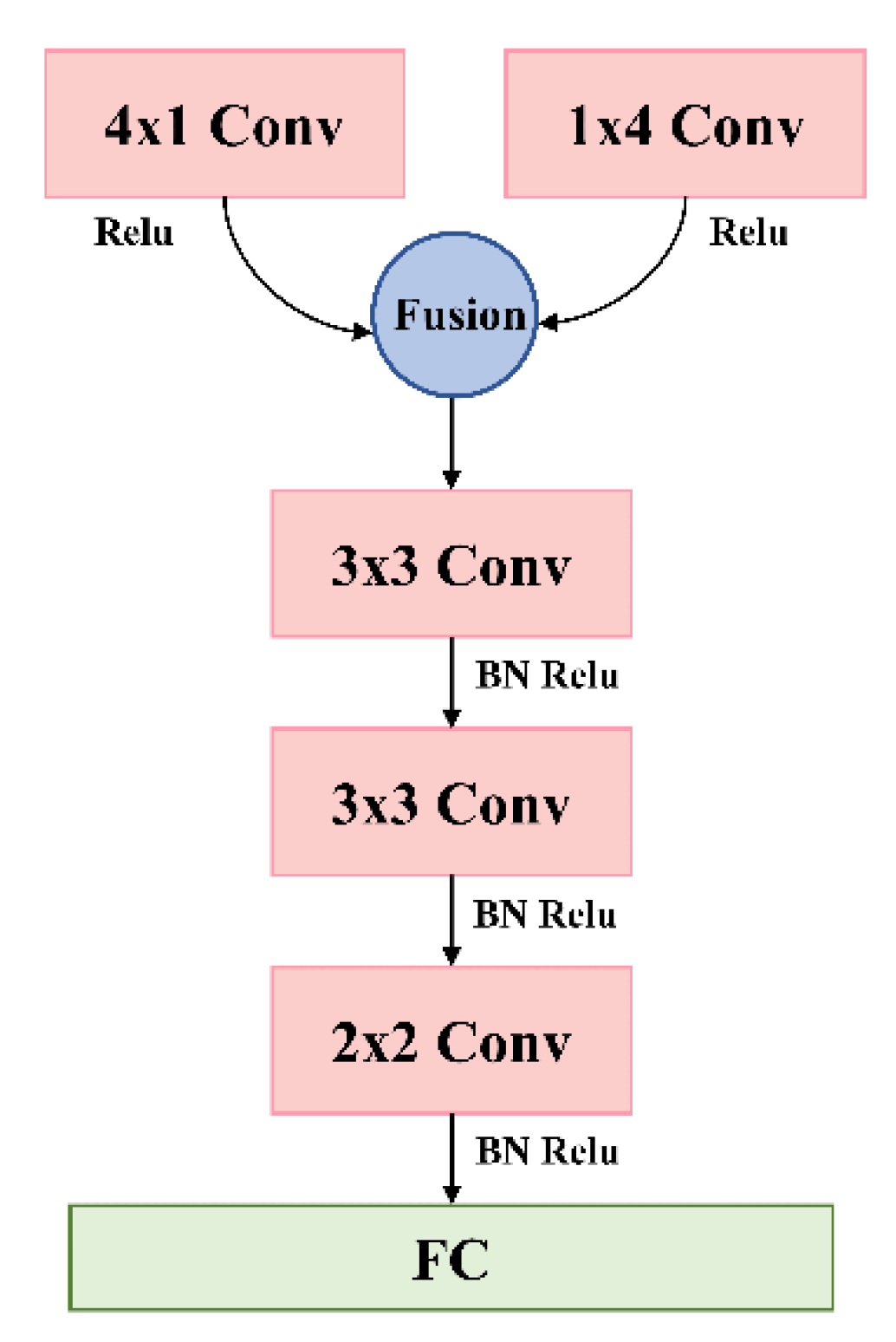
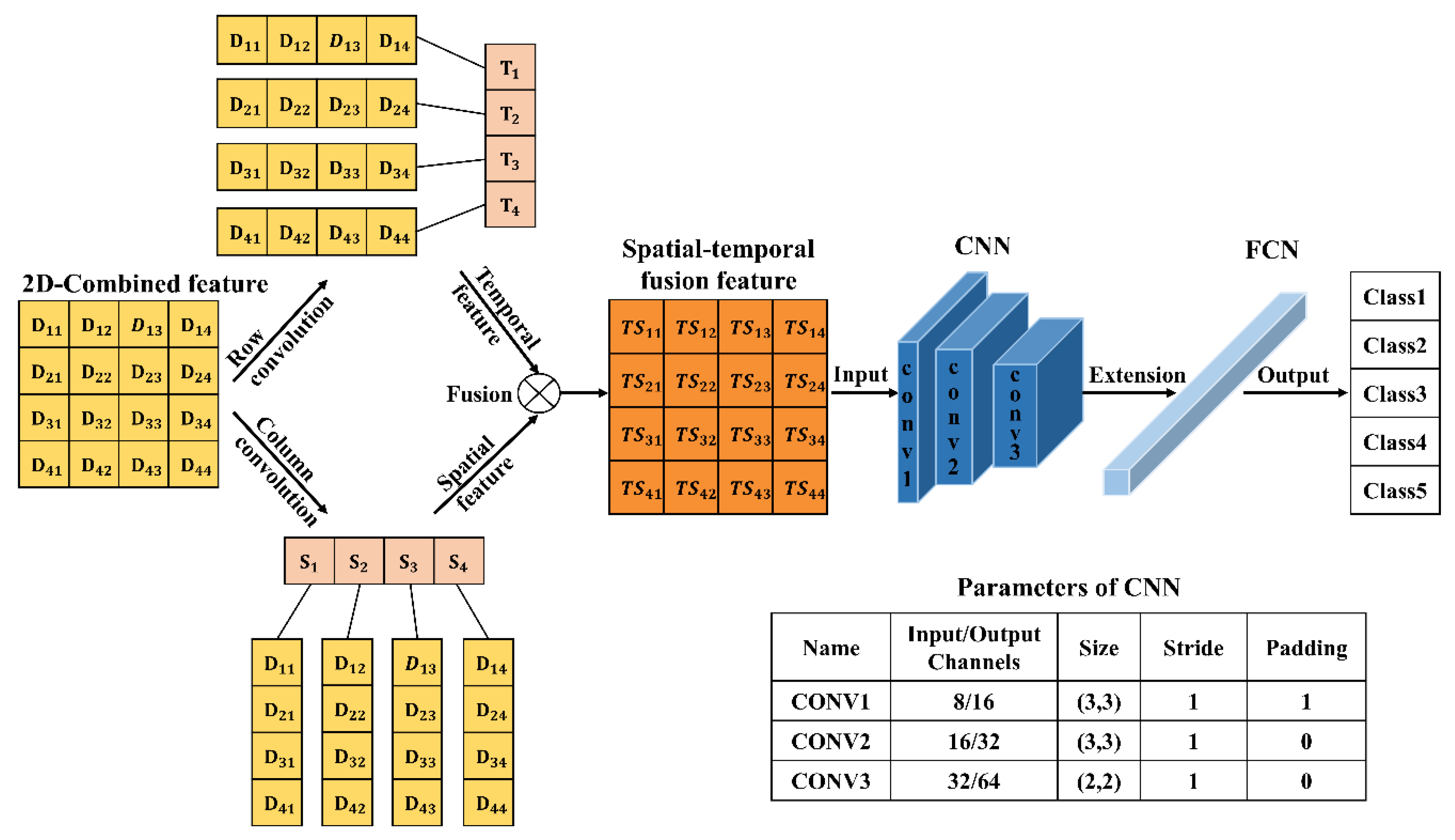
3. Results and discussion
3.1 Experimental platform and datasets
3.2 Classification results
| Set | Layer number | Layer type | Input channel | Output channel | Convolutional kernel size | Stride | Padding | Parameters |
| 1 | 1 | Conv | 8 | 16 | 3×3 | 1 | 1 | 66 kB |
| 2 | Conv | 16 | 32 | 3×3 | 1 | 0 | ||
| 3 | Conv | 32 | 64 | 2×2 | 1 | 0 | ||
| 2 | 1 | Conv | 8 | 32 | 3×3 | 1 | 1 | 158 kB |
| 2 | Conv | 32 | 64 | 3×3 | 1 | 0 | ||
| 3 | Conv | 64 | 64 | 2×2 | 1 | 0 | ||
| 3 | 1 | Conv | 8 | 32 | 3×3 | 1 | 1 | 295 kB |
| 2 | Conv | 32 | 128 | 3×3 | 1 | 0 | ||
| 3 | Conv | 128 | 64 | 2×2 | 1 | 0 | ||
| 4 | 1 | Conv | 8 | 16 | 3×3 | 1 | 1 | 66 kB |
| 2 | Conv | 16 | 32 | 3×3 | 2 | 1 | ||
| 3 | Conv | 32 | 64 | 2×2 | 1 | 0 | ||
| 5 | 1 | Conv | 8 | 16 | 3×3 | 1 | 1 | 66 kB |
| 2 | Conv | 16 | 32 | 3×3 | 2 | 1 | ||
| 3 | Conv | 32 | 64 | 2×2 | 2 | 0 |
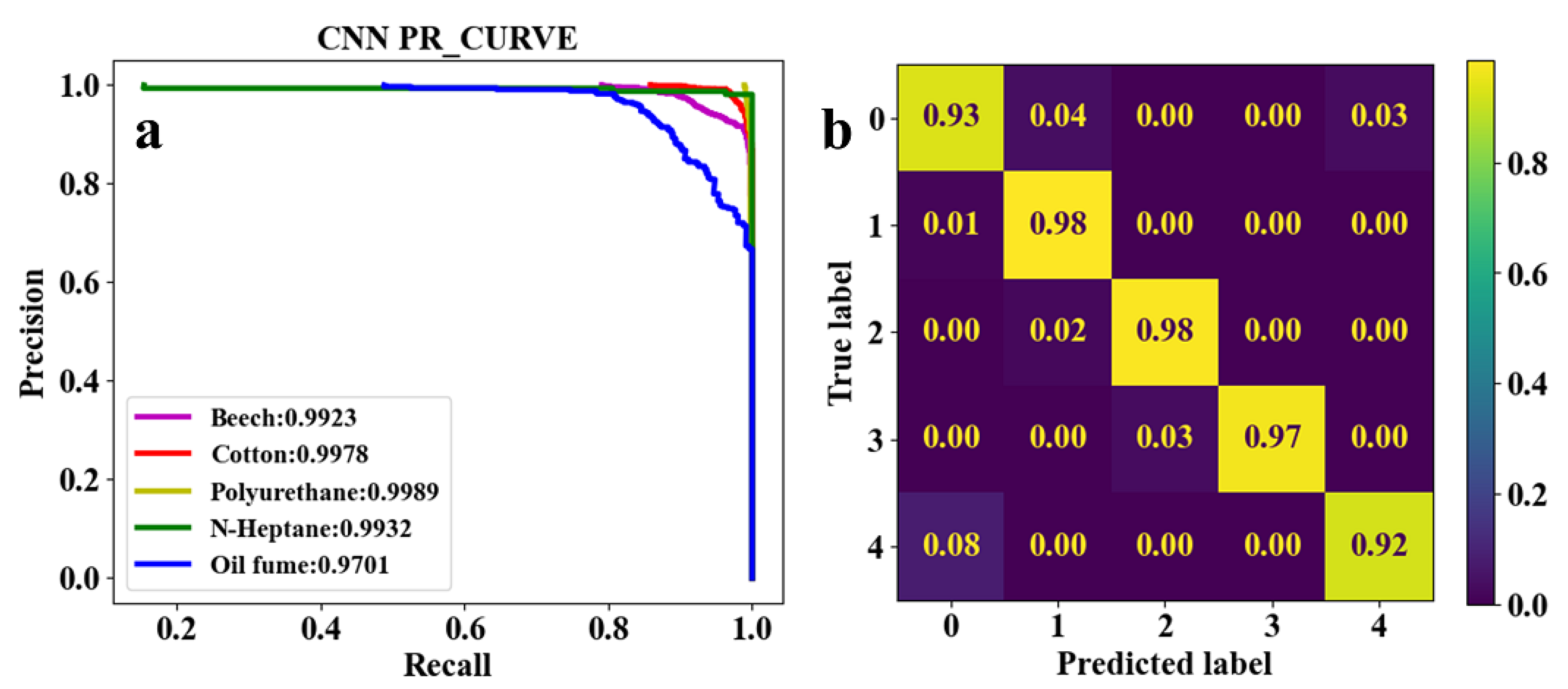
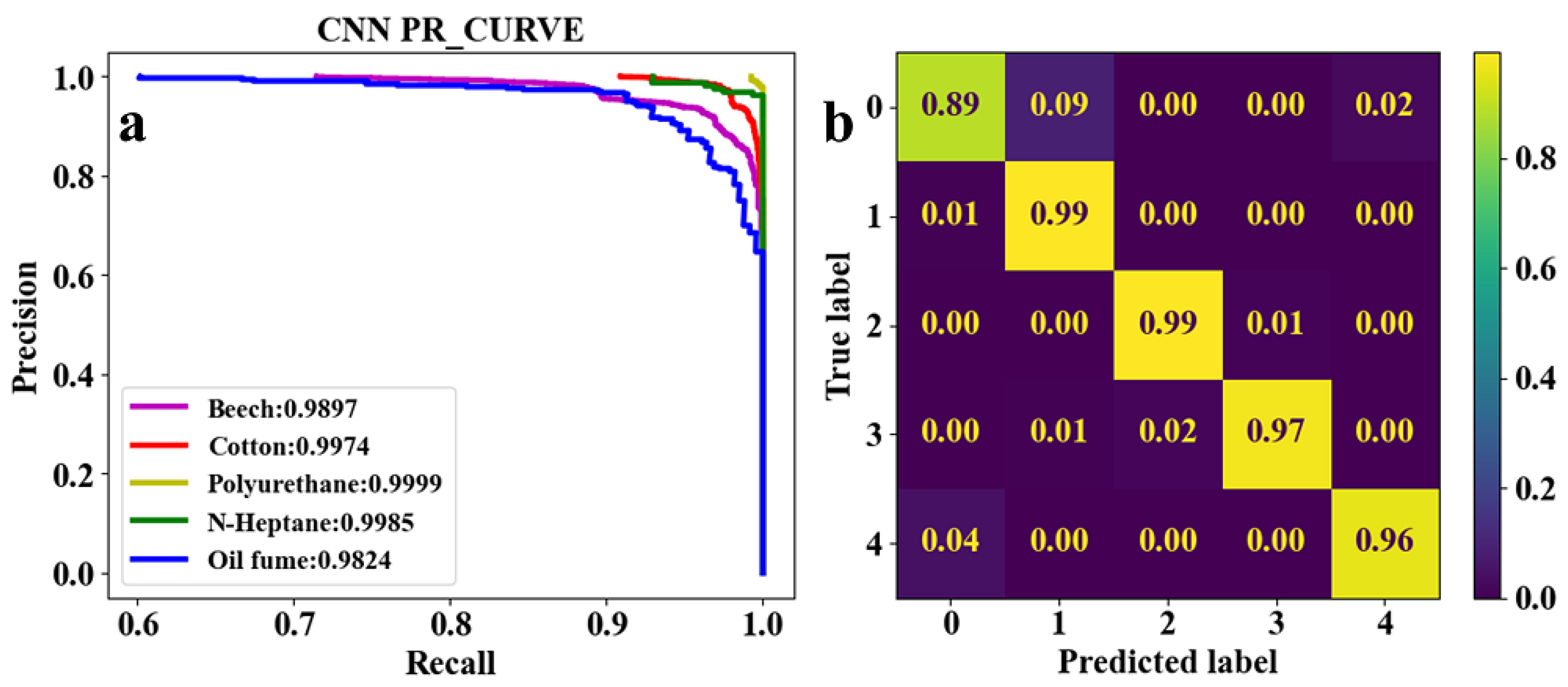
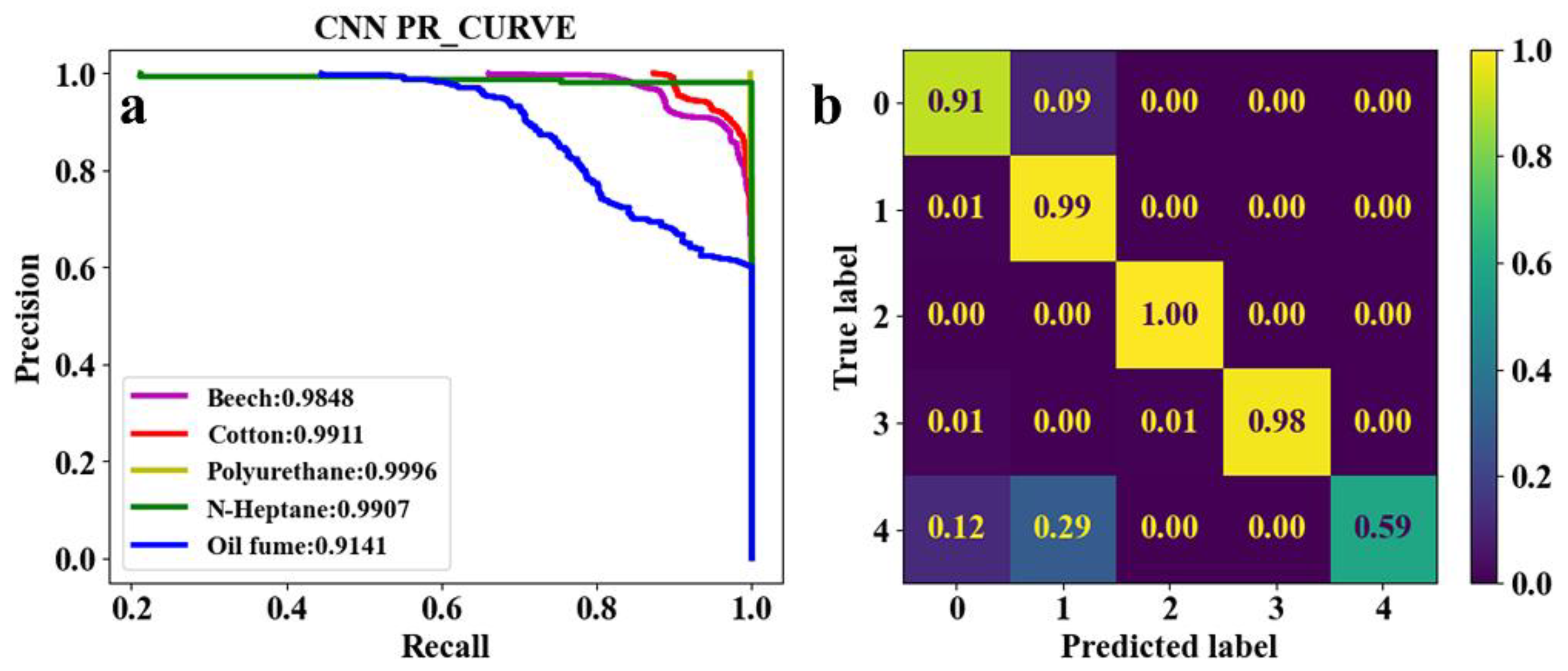
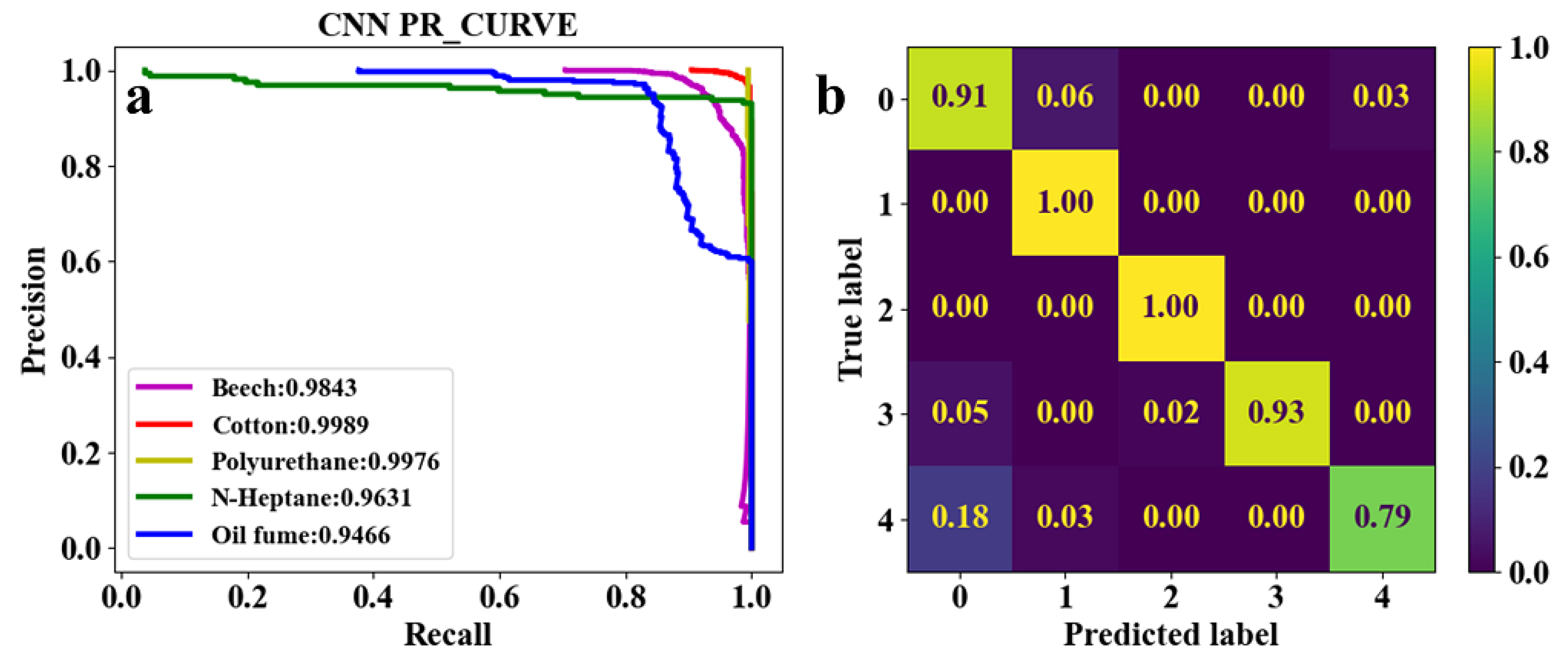
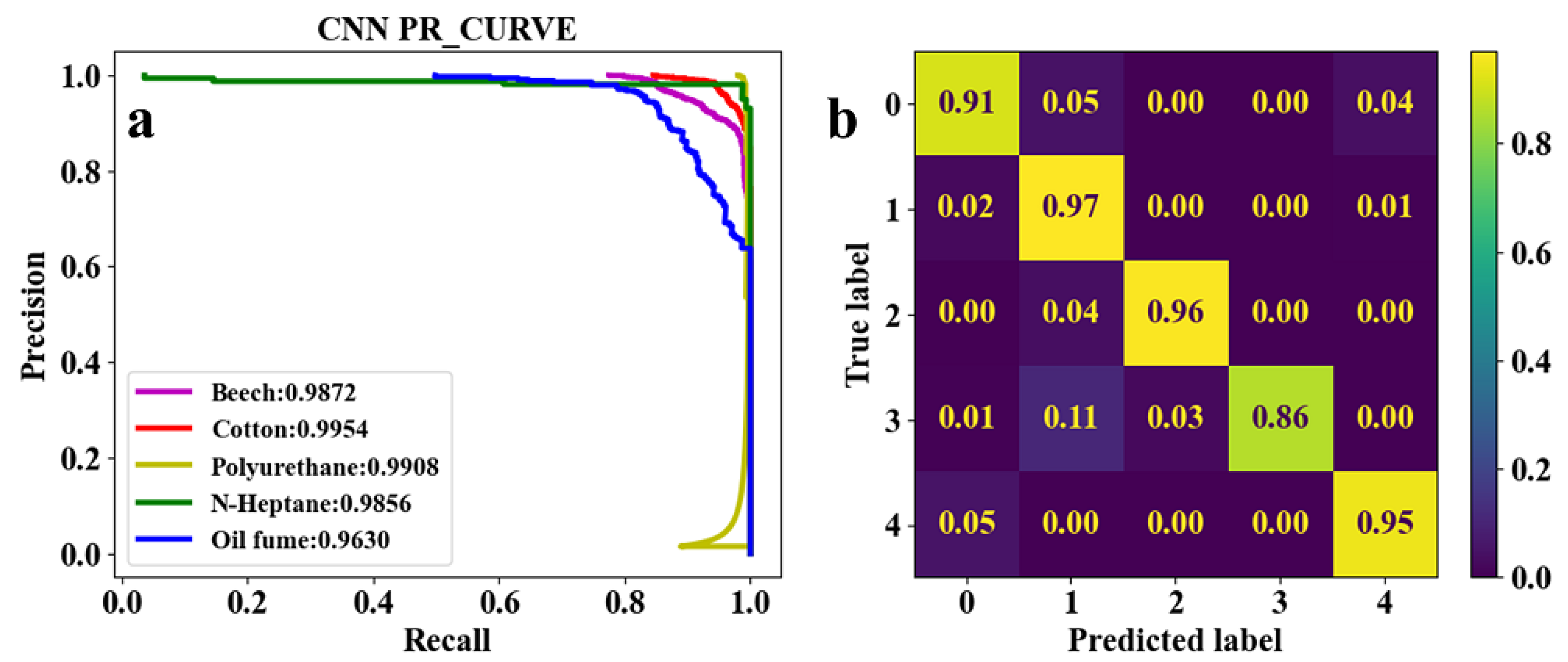
4. Conclusions
Author Contributions
Funding
Conflicts of Interest
References
- J. Baek, T. J. Alhindi, Y. Jeong, M. K. Jeong, S. Seo, J. Kang, W. Shim, Y. Heo, Real-time fire detection system based on dynamic time warping of multichannel sensor networks, Fire Saf. J., 123(2021), 103364. [CrossRef]
- G. Xu, Y. Zhang, Q. Zhang, G. Lin, J. Wang, Deep domain adaptation based video smoke detection using synthetic smoke images, Fire Saf. J., 93(2017), pp. 53-59. [CrossRef]
- G. Xu, Y. Zhang, Q. Zhang, G. Lin, Z. Wang, Y. Jia, J. Wang, Video smoke detection based on deep saliency network, Fire Saf. J., 105(2019), pp. 277-285. [CrossRef]
- C. Li, B. Yang, H. Ding, H. Shi, X. Jiang, J. Sun, Real-time video-based smoke detection with high accuracy and efficiency, Fire Saf. J., 117(2020), 103184. [CrossRef]
- Y. Huo, Q. Zhang, Y. Zhang, J. Zhu, J. Wang, 3DVSD: An end-to-end 3D convolutional object detection network for video smoke detection, Fire Saf. J., 134(2022), 103690. [CrossRef]
- H. Jang, C. Hwang, Obscuration threshold database construction of smoke detectors for various combustibles, Sensors, 20(2020), 6272. [CrossRef]
- T. Cleary, G. Taylor, Evaluation of empirical evidence against zone models for smoke detector activation prediction, fire technol., 59(2023), pp. 3129-3156. [CrossRef]
- A.S. Pundir, B. Raman, Dual deep learning model for image-based smoke detection, Fire Technol., 55(2019), pp. 2419–2442. [CrossRef]
- T. Liu, J. Cheng, X. Du, X. Luo, L.Zhang, B. Cheng, Y. Wang, Video smoke detection method based on change-cumulative image and fusion deep network, Sensors, 19(2019), 5060. [CrossRef]
- X. Zheng, F. Chen, L. Lou, P. Cheng, Y. Huang, Real-time detection of full-scale forest fire smoke based on deep convolution neural network, Remote Sens., 14(2022), 536. [CrossRef]
- X. Li, J.S.R. Sáez, A. Vázquez-López, X. Ao, R.S. Díaz, D. Wang, Eco-friendly functional cellulose paper as a fire alarming via wireless warning transmission for indoor fireproofing, Ind. Crop. Prod., 200(2023), 116805. [CrossRef]
- S. Festag, False alarm ratio of fire detection and fire alarm systems in Germany-A meta analysis, Fire Saf. J., 79(2016), pp. 119-126. [CrossRef]
- M. Jiang, Y. Zhao, F. Yu, C. Zhou, T. Peng, A self-attention network for smoke detection, Fire Saf. J., 129(2022), 103547. [CrossRef]
- M. Lin, M. Z, X. Xiao, C. Li, J. Wu, Optical sensor for combustion aerosol particle size distribution measurement based on embedded chip with low-complexity Mie scattering algorithm, Opt. Laser Technol., 158(2023), 108791. [CrossRef]
- M. Lin, M. Zhu, C. Li, Aerosol Sauter mean diameter measurement based on the light scattering response of the combined particle volume-surface area, Opt. Express, 31(2023), pp. 3490-3503. [CrossRef]
- M. Lin, M. Zhu, C. Li, Y. Chen, In situ optical sensor for aerosol ovality and size, Sensor. Actuat. A-Phys., 347(2022), 113963. http://doi.10.1016/j.sna.2022.113963.
- M. Loepfe, P. Ryser, C. Tompkin, D. Wieser, Optical properties of fire and non-fire aerosols, Fire Saf. J., 29(1997), pp. 185-194. [CrossRef]
- T. Deng, S. Wang, X. Xiao, M. Zhu, Eliminating the effects of refractive indices for both white smokes and black smokes in optical fire detector, Sensor. Actuat. B-Chem., 253(2017), pp. 187-195. [CrossRef]
- T. Chaudhry, K. Moinuddin, Method of identifying burning material from its smoke using attenuation of light, Fire Saf. J., 93(2017), pp. 84-97. [CrossRef]
- N. Qu, Z. Li, X. Li, S. Zhang, T. Zheng, Multi-parameter fire detection method based on feature depth extraction and stacking ensemble learning model, Fire Saf. J., 128(2022), 103541. [CrossRef]
- M. Yu, H. Yuan, K. Li, J. Wang, Research on multi-detector real-time fire alarm technology based on signal similarity, Fire Saf. J., 136(2023), 103724. [CrossRef]
- G. Liu, H. Yuan, L. Huang, A fire alarm judgment method using multiple smoke alarms based on Bayesian estimation, Fire Saf. J., 136(2023), 103733. [CrossRef]
- R. Zheng, S. Lu, Z. Shi, C. Li, H. Jia, S. Wang, Research on the aerosol identification method for the fire smoke detection in aircraft cargo compartment, Fire Saf. J., 130(2022), 103574. [CrossRef]
- G. Mie, Beiträge zur optik trüber medien, speziell kolloidaler metallösungen, Annn. Phys. 330(1908), pp. 377-445.
- Q. Xie, H. Yuan, H. Guo, Experimental study on false alarms of smoke detectors caused by kitchen oil fume, Fire Sci. Technol., 22(2003), pp. 504-507. [CrossRef]
- M.A. Jackson, I. Robins, Gas sensing for fire detection: Measurements of CO, CO2, H2, O2, and smoke density in European standard fire tests, Fire Saf. J., 22(1994), pp. 181-205. [CrossRef]
- ISO 7240-9, Fire Detection and Alarm Systems--Part 9: Test Fires for Fire Detectors [S], 2012.
- L. Shen, Z. Mei, W. Zheng, Research on multi-information data of cooking fumes in standard combustion room. Fire Safety Science, 2008. DOI:10.3901/JME.2008.05.160.
- E.R. Coffey, D. Pfotenhauer, A. Mukherjee, Kitchen area air quality measurements in northern Ghana: evaluating the performance of a low-cost particulate sensor within a household energy study, Atmosphere, 400(2019), pp. 1–27. [CrossRef]
- W.C. Tam, E.Y.Fu, A. Mensch, A. Hamins, C. You, G. Ngai, H. Leong, Prevention of cooktop ignition using detection and multi-step machine learning algorithms, Fire Saf. J., 120(2021), 103043. [CrossRef]
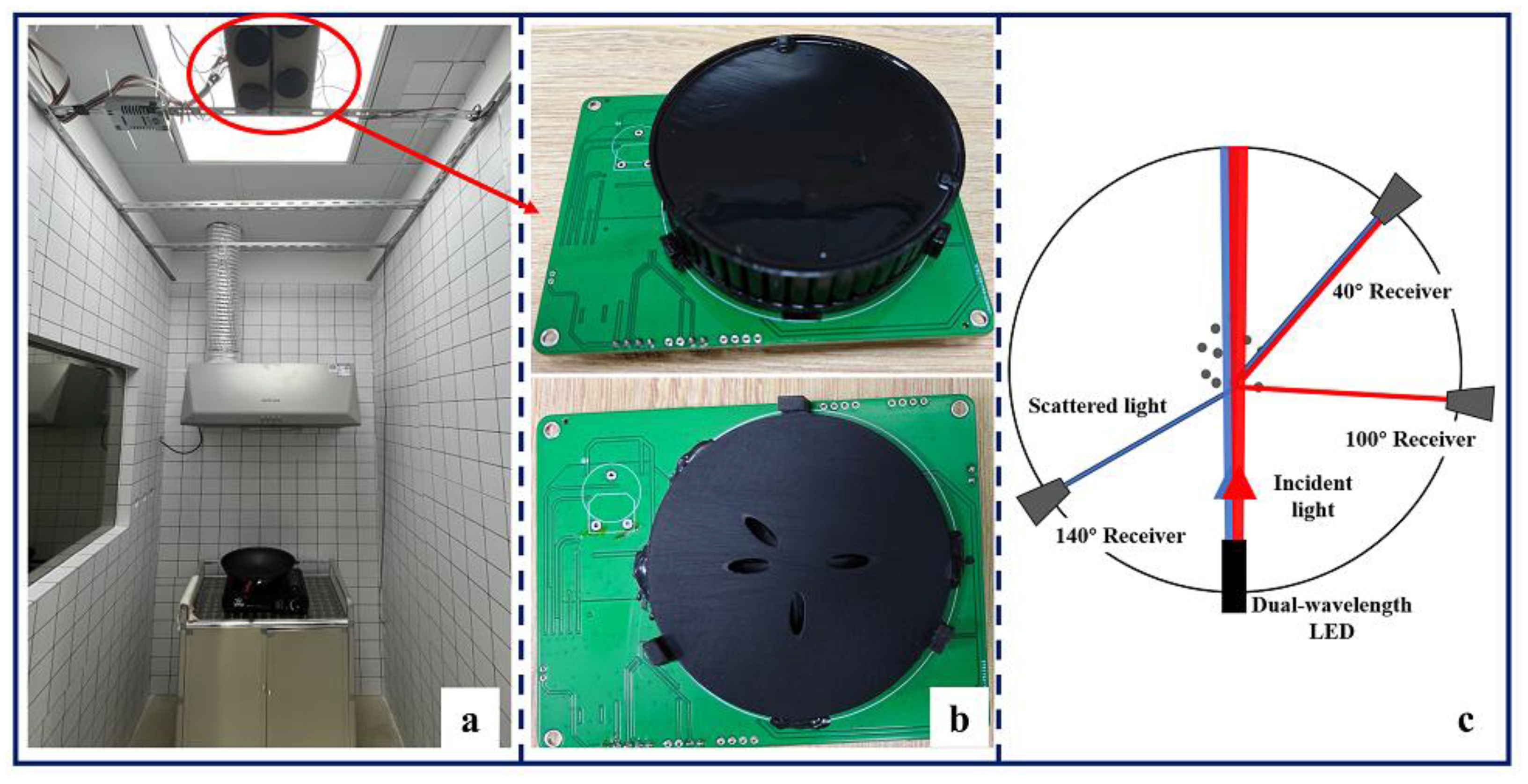
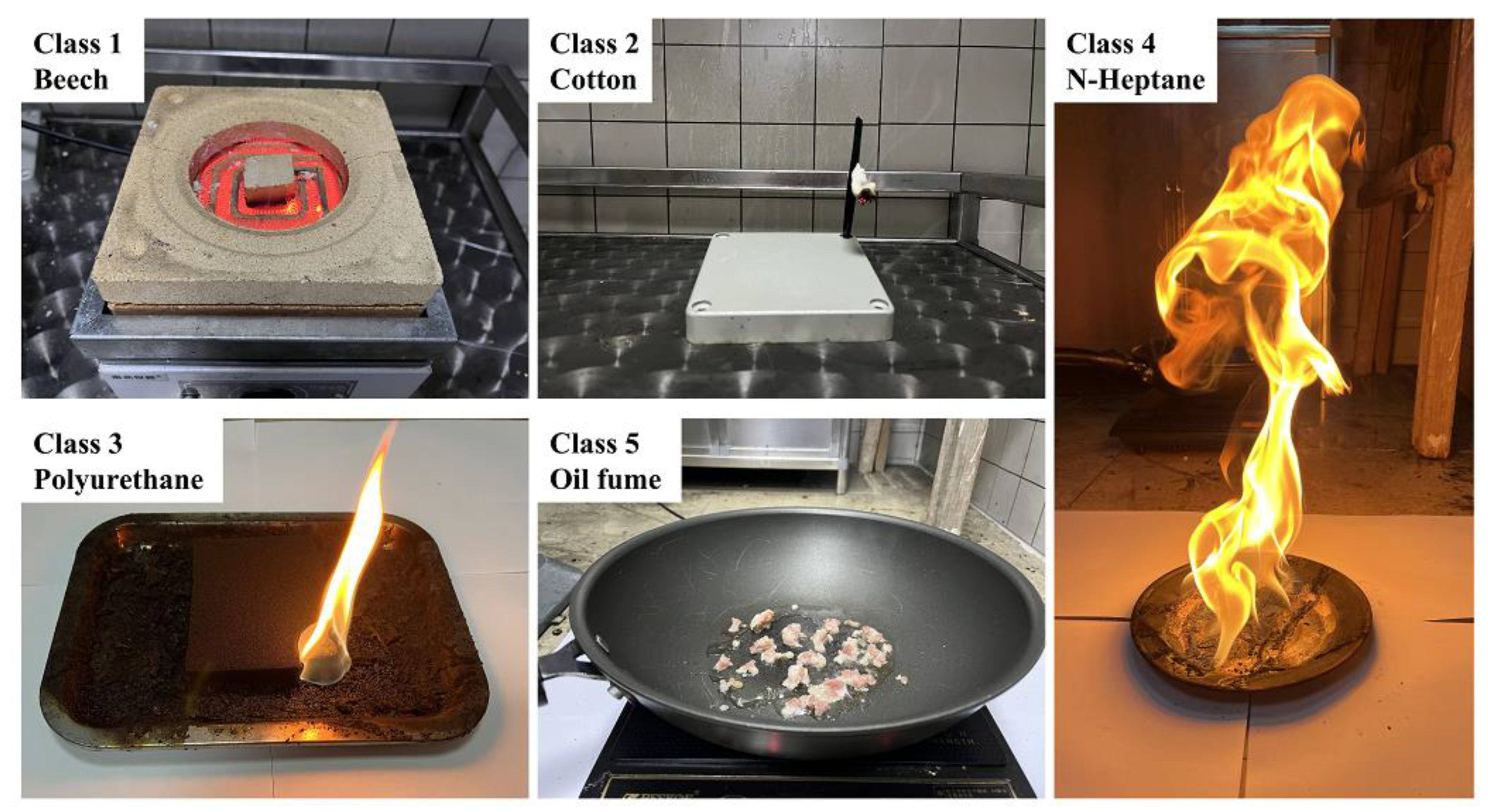
Disclaimer/Publisher’s Note: The statements, opinions and data contained in all publications are solely those of the individual author(s) and contributor(s) and not of MDPI and/or the editor(s). MDPI and/or the editor(s) disclaim responsibility for any injury to people or property resulting from any ideas, methods, instructions or products referred to in the content. |
© 2023 by the authors. Licensee MDPI, Basel, Switzerland. This article is an open access article distributed under the terms and conditions of the Creative Commons Attribution (CC BY) license (http://creativecommons.org/licenses/by/4.0/).




